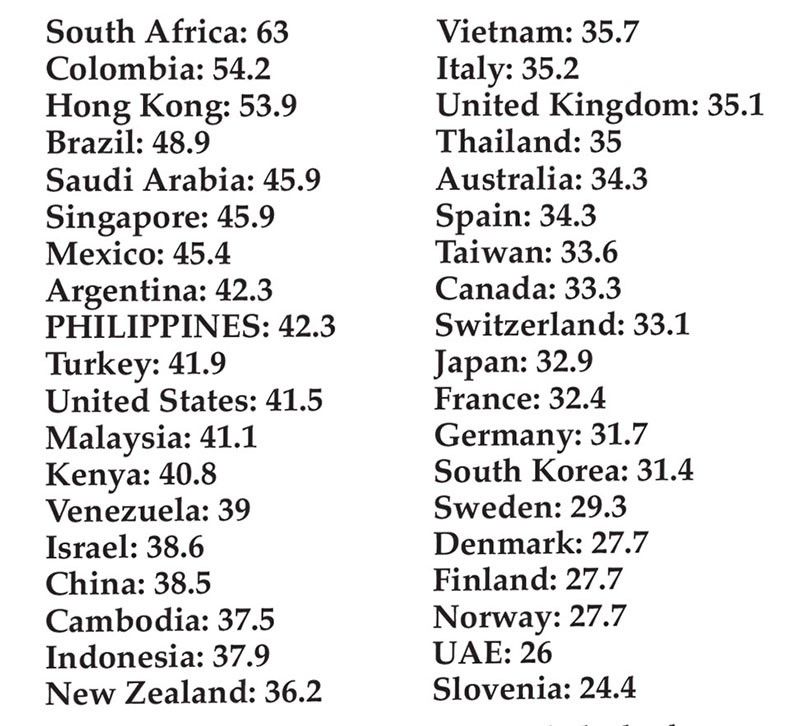Measuring income inequality

In a recent report about the Philippine economy, the Philippine Institute for Development Studies (PIDS) stated that the economy will grow at a faster pace this year. The emphasis of the report was on the projections for economic growth measured in terms of the Gross Domestic Product (GDP).
This economic report followed the traditional emphasis on GDP and did not contain anything about income inequality. It is understandable that the government economic plans are focused on programs that will increase the pace of GDP. There is, as far as I know, no single comprehensive and focused program on alleviating income inequality.
The new secretary of finance Ralph Recto has announced that there will be no new taxes and has been lauded for this announcement. The truth is that there is actually a need to increase taxes, focused on the upper class or the wealthiest one percent. For example, income tax, even though it is progressive, still puts unnecessary burden even on those who earn below the living wage. The tax on dividends benefits primarily only the very rich. The ordinary citizen cannot afford to buy shares in companies that declare dividends regularly. At the same time, the government relies on consumption taxes such as those on soft drinks, grocery items and fuel, LPG which are consumed even by the poor households.
The GINI Coefficient is a statistical measurement of income inequality and economic concentration. It was developed by the Italian economist Corrado Gini in 1912 and has since been used as a measurement for inequality for countries. The measurement ranges from 0 to 100, with the higher number indicating greater inequality. A low GINI Coefficient implies that there is less economic disparity within a given society, meaning a more equitable distribution of wealth and resources.
The process for computation is too technical and I will not go into it. But here is a sampling of GINI Coefficient of certain countries ranging from the most unequal to the most equal.

It is noticeable that in countries with the highest rate of inequality, the rise of populism in its politics is noticeable. This is the reason why even in the richest country in the world, the US, has seen the rise of Donald Trump with his message of populism. Populism is defined as “a political approach that strives to appeal to ordinary people who feel that their concerns are disregarded by established elite groups.” In other words, the masses believe that the wealth gap has become too wide and that they are being exploited by the elite class.
I think this could be the reason for the popularity of politicians like a Duterte who has tried to project an image of a man of the masses against the elite. I was surprised by the very high GINI Coefficient of countries like Hong Kong and Brazil. I believe that the populist uprising that happened in Hong Kong during the Yellow Umbrella movement was led by students but won overwhelmingly in local elections despite the image of prosperity.
Brazil is considered one of the most prosperous nations in Latin America. However, it is also famous for its widespread favelas or shantytowns which highlight the income inequality in the country.
In the United States, there is an emerging group of political leaders who have been advocating that the root cause of the problems in that country is the high rate of income inequality. Its leaders are Sen. Bernie Sanders, Sen. Elizabeth Warren and Rep. Alexandria Ocasio-Cortez.
In the 2024 Oxfam Report which I wrote about last Sunday, it said: “A radical increase in equality must be humanity’s most urgent priority. Rapidly and radically reducing the gap between the richest and the rest of society is vital to ensuring a good life for all, on a planet that is flourishing, not struggling to survive. Governments throughout the world need to develop concrete plans for inequality reduction and better capture the impact of their policies on reducing income inequality.”
Aside from increasing taxation on the wealth of the elite one percent, the Oxfam Report outlined three practical steps that would limit corporate power. The first is to revitalize the state as a remedy to correct the failure of capitalism for a more equitable distribution of wealth. Health and education should be free of charge, paid for by progressive taxation.
Government must use their power to rein in the runaway power of corporations by breaking up private monopolies and preventing corporate power from becoming too large.
According to Oxfam, the damaging effects of increased concentration of wealth and the automation of industry “… demand that we create a different way of doing business.”
These three steps towards reducing income inequality through reducing corporate monopolies demand radical solutions.
I look forward to reports from our economic managers which will include the state of income inequality in our country.
- Latest
- Trending

























